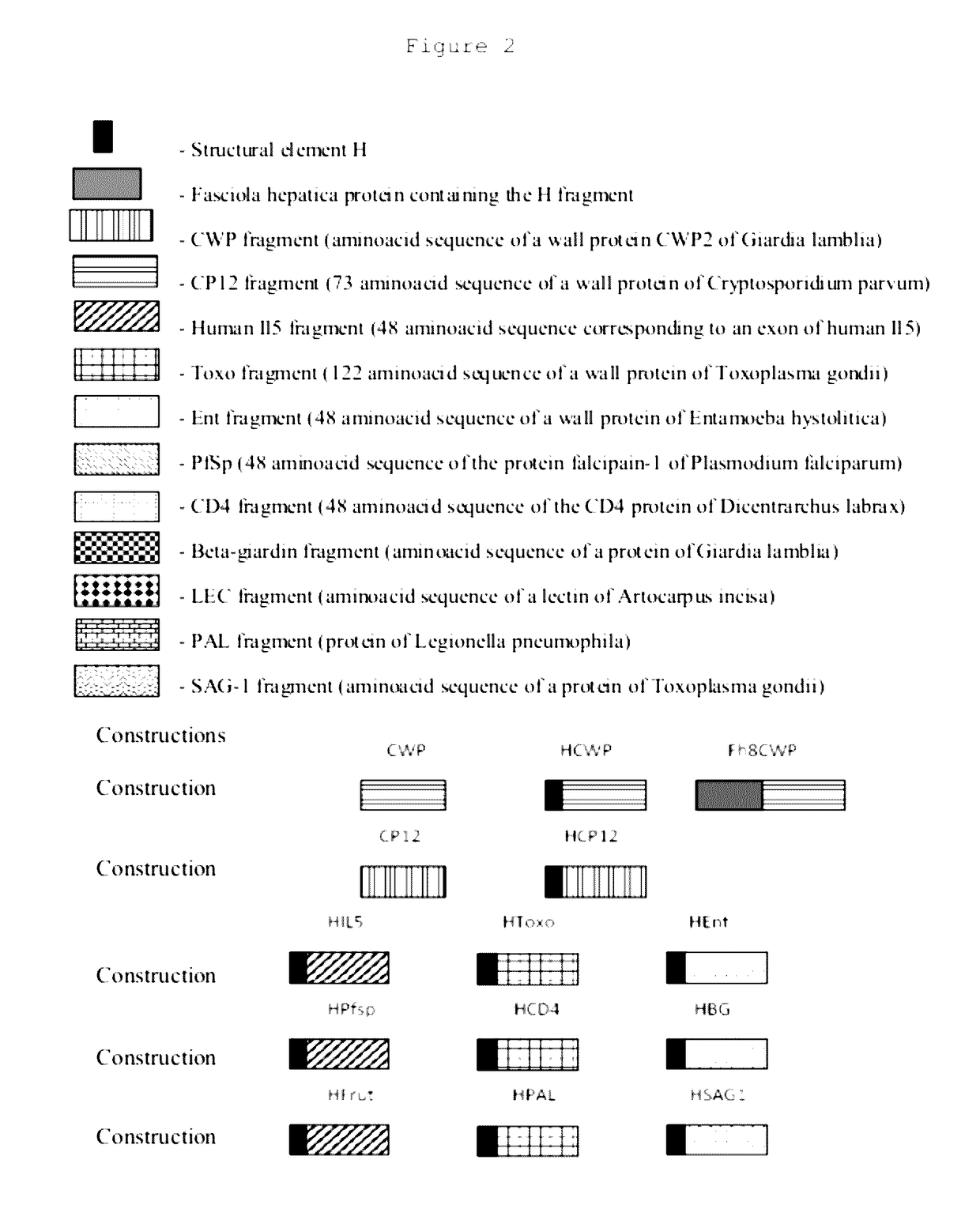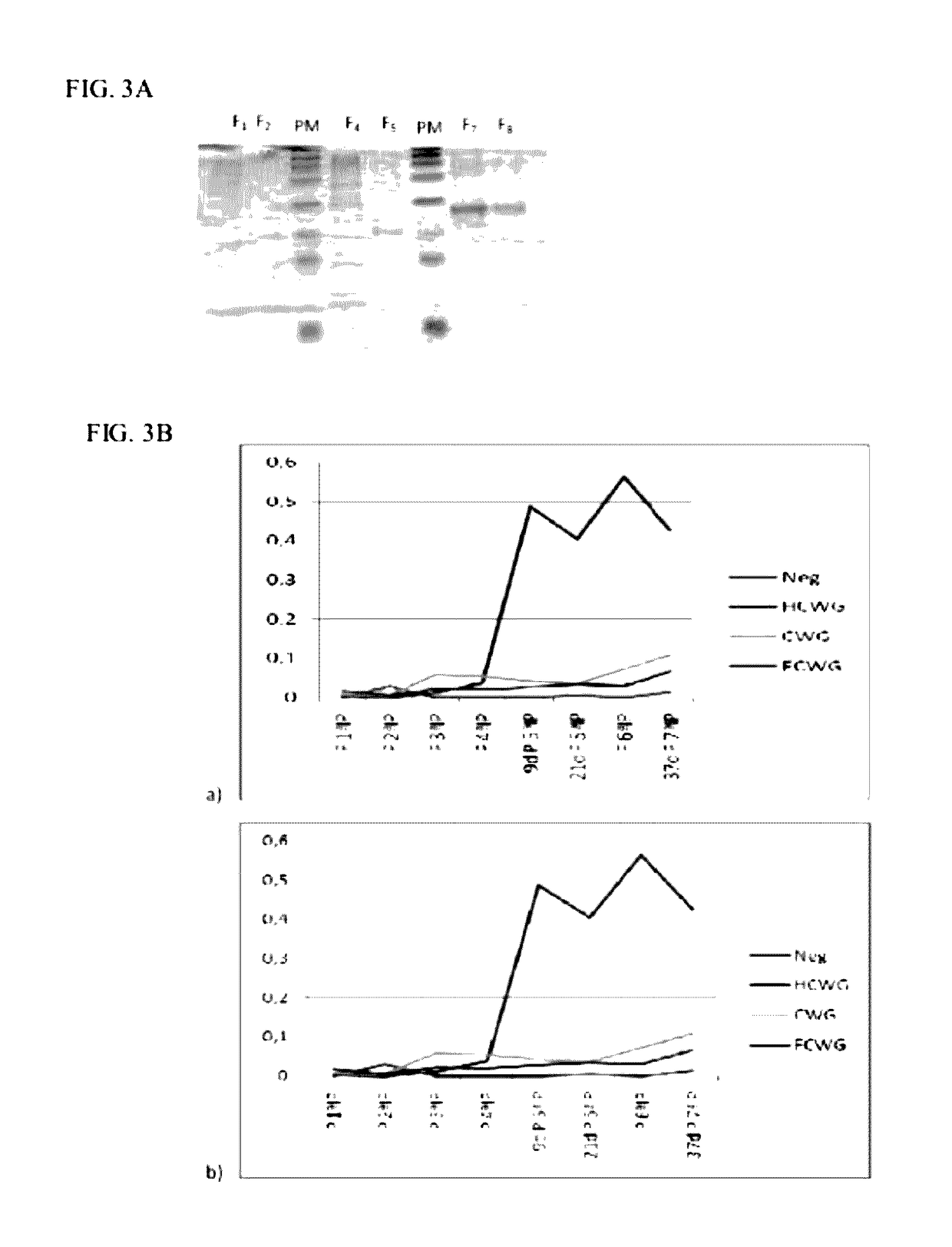Immunogens, compositions and uses thereof, method for preparing same
a technology of immunogens and compositions, applied in the field of immunogen preparations, can solve the problems of difficult to predict the most effective adjuvant for a particular protein or peptide, the existence of immunity to that protein is a major limitation, and the toxicity of these proteins is the main obstacle to their use, so as to increase the immunogenicity of these molecules and amplify the immune response
- Summary
- Abstract
- Description
- Claims
- Application Information
AI Technical Summary
Benefits of technology
Problems solved by technology
Method used
Image
Examples
example 1
Evaluation of the Immune Response in Proteins Resulting of the Constructs with the Fragment CWG
[0117]After obtaining the b constructs pQECWG, pQEHCWG and pQEFCWG we proceeded to the production and analysis of the respective recombinant antigens under denaturing conditions (FIG. 3A).
[0118]In the analysis of SDS-PAGE Tris-Tricine gels (FIG. 3A) we can see that the protein CWG has a molecular weight of 16 kDa, as expected, while the fusion protein HCWG has a weight of about 17 kDa and the recombinant antigen FCWG has a weight of about 24 kDa.
[0119]Demonstration of the effect of the presence of the fragment H on the induction of a specific immune response against the CWG has been performed by inoculation with 3 groups of CD1 mice with 50 μg of antigen CWG, HCWG and FCWG, regularly (Table 2) by IP administration. He used also a group of 3 CD1 with the same characteristics that received no inoculation. There has been regular blood collection (Table 2) for further evaluation of the presenc...
example 2
Evaluation of the Immune Response for Proteins of the Constructs with the CP12 Fragment
[0120]After obtaining the constructs pQECP12 and pQEHCP12 we proceeded to the production and analysis of the respective recombinant antigens under denaturing conditions (FIG. 4A).
[0121]In the analysis of SDS-PAGE Tris-Tricine gels (FIG. 3A) we can see that the CP12 protein has a molecular weight of 9 kDa, as expected, while the fusion protein HCP12 has a weight of approximately 10 kDa and the recombinant antigen FCP12 presents an antigen with weight of about 29 kDa. Having regard to the PM calculated for the recombinant antigen, the band of 29 kDa may be a polymer FCP12. Demonstration of the effect of the presence of the fragment H on the induction of a specific immune response against the CP12 has been performed by inoculation with 2 groups of CD1 mice with 20 μg of antigen CP12 and HCP12 periodically (Table 2) by IP administration. We also used a group of 3 CD1 with the same characteristics that...
example 3
Evaluation of Immune Response Proteins and Fragments Resulting from the Construction with the Fragment H
[0123]For each of the fragments described we proceeded to demonstration on the production of immune response inoculating 3 groups of CD1 mice with the corresponding antigen at regular intervals (Table 2) by IP administration. We also used a group of 3 CD1 with the same characteristics that received no inoculation. There has been regular blood collection (Table 2) for further evaluation of the presence of Ig directed against the target antigen.
[0124]Protein BG: The immunological features on this fragment were unknown. After obtaining the construct pQEHBG we proceeded to the production and analysis of the respective recombinant antigens (FIG. 5A). Demonstration of the effect of the presence of the fragment H on the induction of a specific immune response against the BG has been performed by inoculation a groups of 3 CD1 mice with 20 μg of antigen HBG. The evaluation of the presence ...
PUM
| Property | Measurement | Unit |
|---|---|---|
| volume | aaaaa | aaaaa |
| volume | aaaaa | aaaaa |
| pH | aaaaa | aaaaa |
Abstract
Description
Claims
Application Information
 Login to View More
Login to View More - R&D
- Intellectual Property
- Life Sciences
- Materials
- Tech Scout
- Unparalleled Data Quality
- Higher Quality Content
- 60% Fewer Hallucinations
Browse by: Latest US Patents, China's latest patents, Technical Efficacy Thesaurus, Application Domain, Technology Topic, Popular Technical Reports.
© 2025 PatSnap. All rights reserved.Legal|Privacy policy|Modern Slavery Act Transparency Statement|Sitemap|About US| Contact US: help@patsnap.com



